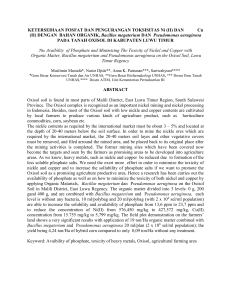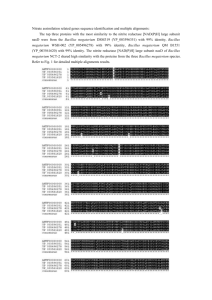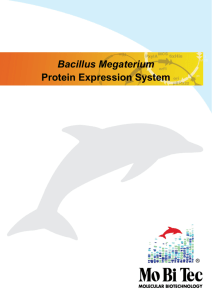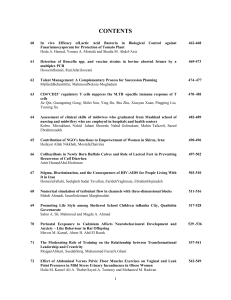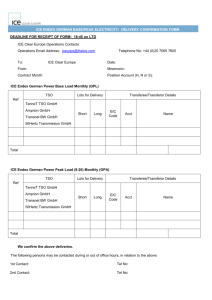Bacillus megaterium Protein Production System
advertisement
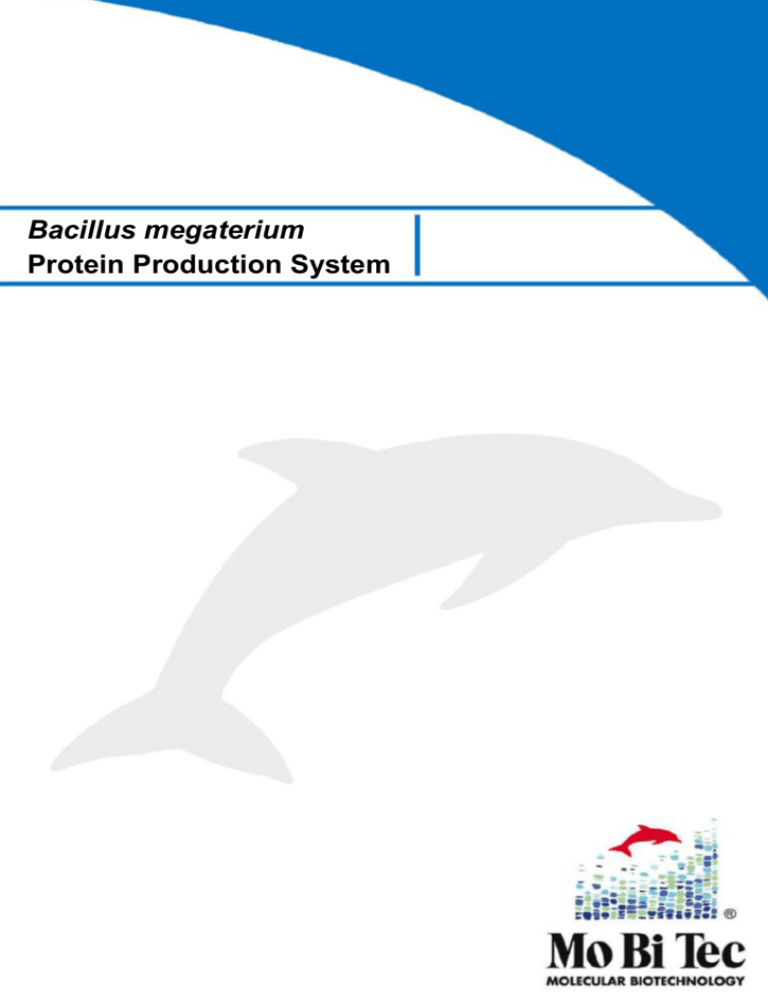
© MoBiTec GmbH 2012 Page 1 Bacillus megaterium Protein Production System MoBiTec GmbH, Germany Phone: +49 551 70722 0 Fax: +49 551 70722 22 E-Mail: info@mobitec.com www.mobitec.com © MoBiTec GmbH 2012 Page 2 Content Content .................................................................................................................................................... 2 1. Introduction .............................................................................................................................................. 3 1.1. General features of Bacillus megaterium .......................................................................................... 3 1.2. Bacillus megaterium as expression host .......................................................................................... 3 2. Summary of Advantages ........................................................................................................................... 4 3. Application Examples ............................................................................................................................... 6 4. Features of the Bacillus megaterium Expression Vectors ........................................................................ 7 5. Protocols ................................................................................................................................................. 14 5.1. Cloning the DNA fragment of interest ............................................................................................. 14 5.2. General remarks on the handling of B. megaterium ....................................................................... 14 5.3. Transformation of Bacillus megaterium protoplasts....................................................................... 14 5.4. Recombinant protein production and secretion ......................................................................... 16 6. Materials ................................................................................................................................................ 18 7. References .............................................................................................................................................. 20 8. Order Information, Shipping and Storage .............................................................................................. 23 9 Contact and Support................................................................................................................................ 24 MoBiTec GmbH, Germany Phone: +49 551 70722 0 Fax: +49 551 70722 22 E-Mail: info@mobitec.com www.mobitec.com © MoBiTec GmbH 2012 Page 3 An efficient alternative to E. coli: Stable protein production with high yield - suited not only for industrial scale. MoBiTec offers this expression system as an easy-to-handle kit with E. coli/B. megaterium shuttle vectors and - to be ordered separately - B. megaterium protoplasts (strains MS941 and WH320) ready for transformation. 1. Introduction 1.1. General features of Bacillus megaterium First described over 100 years ago, B. megaterium has recently been gaining more and more importance in scientific as well as industrial applications. The source of its significant name "megaterium" is its large size of the vegetative cells (over 10 μm) and its spores. The capability of sporulation has made B. megaterium an important tool for examining spore-mediated disease and cell development. B. megaterium is able to grow on a wide variety of carbon sources and thus has been found in many ecological niches such as waste from meat industry or petrochemical effluents. Also, the degradation of persistent insecticides by B. megaterium has been documented (Saxena et al., 1987; Selvanayagam and Vijaya, 1989) offering potential applications as detoxifying agent. One of the genetic regulatory elements for carbon utilization is the xylose operon. It has been described by Rygus and Hillen (1991) and is used in the expression system MoBiTec is offering in this kit. Further, several B. megaterium proteins are of importance. For example, a family of P450 cytochrome monooxygenases is similar to eukaryotic P450 playing a role in many diseases. Industrial applications of enzymes excreted by B. megaterium are diverse, starting from amylases used in bread industry to penicillin amidase which is used for the generation of new synthetic antibiotics. An overview about the features of this unique organism is given in review articles as "Prime time for Bacillus megaterium" (Vary, 1994), “A short story about a big magic bug” (Bunk et al., 2010) and “Bacillus megaterium - from simple soil bacterium to industrial protein production host“ (Vary et al. 2007). 1.2. Bacillus megaterium as expression host In molecular biology, B. megaterium has been proven to be an excellent host for the expression of non-homologous DNA. All cloning vectors of the B. megaterium system (all are derivatives of the original pWH1520 (Fig. 1) (Rygus and Hillen, 1991; Malten et al., 2006; Biedendieck et al., 2007)) rely on the above mentioned xylose inducible expression system used as regulatory element. Remarkable improvement work was done by R. Biedendieck. In contrast to other bacilli strains B. megaterium has the advantage, that no alkaline protease is present. This fact enables excellent production and secretion of foreign MoBiTec GmbH, Germany Phone: +49 551 70722 0 Fax: +49 551 70722 22 E-Mail: info@mobitec.com www.mobitec.com © MoBiTec GmbH 2012 Page 4 proteins without degradation (Meinhardt et al., 1989; Rygus and Hillen, 1991). In addition, due to its Gram-positive character there are no endotoxins found in the cell wall. Protein yields are exceptionally good, also if inexpensive substrates are used. Recombinant plasmids are structurally and segregationally stable. For example, the B. megaterium glucose dehydrogenase gene (ghd) has been cloned back into a B. megaterium expression vector. The vector and the production of Ghd remained stable without selective pressure over a period of three weeks with daily subculturing (Meinhardt et al., 1989). Several proteins have successfully been overproduced in B. megaterium (see chapter 3). Rygus and Hillen (1991) describe cloning and expression of the genes lacZ from E. coli, gdh from B. megaterium, mro (mutarotase) from Acinetobacter and human puk (a urokinase-like plasminogen activator, rscuPA). Using the xylose operon the genes were 130- to 350-fold induced without proteolysis. Such a system offers unique possibilities for the industrial production of proteins. Further, it is of great interest to manufacturers in the biomedical field. In a diagnostic test for AIDS, the HIV coat protein is commercially produced by B. megaterium (Ginsburgh et al., 1989). 2. Summary of Advantages B. megaterium is not pathogenic No endotoxins found in the cell wall Tightly regulated and efficiently inducible xylA operon (up to 350-fold) Stable, high yield protein production No indication of proteolytic instability even up to 5 h after induction, since alkaline proteases such as e.g. in B. subtilis are not produced Suited for small to industrial-scale protein production Plasmids available for either intra- or extracellular production of recombinant proteins Extended polylinker downstream of promoter allows versatile cloning Easy purification and detection of either 6xHis, Strep-tagged or Strep-/6xHis-doubletagged target proteins Removable purification tags due to TEV and Factor Xa protease cleavage sites Compatible with all Bacillus subtilis vectors Host strains MoBiTec offers have been found to be asporogenic on common media System might be suitable also for other Bacillus ssp. MoBiTec GmbH, Germany Phone: +49 551 70722 0 Fax: +49 551 70722 22 E-Mail: info@mobitec.com www.mobitec.com © MoBiTec GmbH 2012 Page 5 See page 10 for DNA sequence of multiple cloning site. Fig. 1. Map of the original pWH1520 shuttle vector for cloning in E. coli and recombinant protein R R R production in B. megaterium. Tet (Bac), tetracycline resistance gene Bacillus; Tet ', Tet '', tetracycline R resistance genes, interrupted; Amp , ampicillin resistance gene; xylR, gene encoding xylose-dependent repressor; xylA', 5’ part of xylose isomerase gene; PA, promoter of xyl-operon; MCS, multiple cloning site; pBC16 ori, Bacillus origin of replication; pBR ori, E. coli ColE1 origin of replication. All vector maps and the complete DNA sequences are available for download on our internet web page www.mobitec.com. MoBiTec GmbH, Germany Phone: +49 551 70722 0 Fax: +49 551 70722 22 E-Mail: info@mobitec.com www.mobitec.com © MoBiTec GmbH 2012 Page 6 3. Application Examples Proteins successfully overproduced with the B. megaterium system: Antibody fragments (scFv, scFab) β-Galactosidase (LacZ) Catabolite control protein (CcpA) Clostridium difficile toxin A Cobaltochelatase (CbiX) Dextransucrase (DsrS) - secreted Endolevanase (LevB) - secreted Formiate dehydrogenase (Fdh) Glucose dehydrogenase (GdhA) Green fluorescent protein (Gfp) Heat shock protein (HPr) from PTS (phosphotransferase sugar transport system) Human single-chain urokinase-like plasminogen activator (rscuPA) Hydrolase of Thermobifida fusca (Tfh) - secreted Levansucrase (Lev773, SacB) - secreted Mannitol dehydrogenase (Mdh) Mutarotase (Mro) Neopullulanase Translocation ATPase of the preprotein translocase (SecA) Trehalose repressor (TreR) Protein yield: Protein yields vary depending on the produced protein itself. Rygus and Hillen (1991) have observed that e.g. Gdh and Mro accumulated to 20% and 30% of the total soluble protein, respectively. The time dependence of the induced expression of these enzymes is shown in Fig. 2. Fig. 2. Time dependence of induced production of the enzymes Gdh (glucose dehydrogenase) and Mro (mutarotase) in B. megaterium. Enzymatic activity is given in U/mg protein. MoBiTec GmbH, Germany Phone: +49 551 70722 0 Fax: +49 551 70722 22 E-Mail: info@mobitec.com www.mobitec.com © MoBiTec GmbH 2012 Page 7 4. Features of the Bacillus megaterium Expression Vectors All plasmids of the here described series contain the strong xylA promoter originating from Bacillus megaterium. Transcription from this promoter is xylose inducible. After xylose addition, the xylose repressor coded by the xylR gene on the plasmids is released from PxylA and transcription is initiated. The most convenient cloning sites for insertion of DNA fragments carrying heterologous genes are located in the reading frame of xylA (see sequences). Therefore, any gene can be expressed using one out of three functionally different fusion strategies. A transcriptional fusion requires that the gene of interest carries its own ribosome binding sequence (RBS) and translation initiation codon. Such a DNA fragment can be fused into any of the available restriction sites within orf1. Whether the resulting transcriptional fusion leads to expression of the gene of interest, which is independent from orf1 expression, depends on the location of the newly created orf1 stop codon with respect to the start codon of the gene of interest (inserting a target gene in one of the polylinker's restriction sites - not in frame with orf1 - may create a new stop codon for translation termination of orf1). lf these stop and start codons are close together, translational coupling may occur, in which the ribosomes translating the orf1 reading frame would terminate at its newly created stop codon, generating a locally high concentration of ribosomes, so that translation initiation at the proximal target gene's start codon would be more efficient compared to a construct in which the orf1 translation terminates farther away from the start codon. On the other hand, if the orf1 reading frame continues for a long distance into the reading frame of the gene of interest, the ribosomes translating the created orf1 fusion protein might inhibit initiation of translation of the protein of interest. Therefore, it is advisable to pay attention to the placement of a stop codon if constructing the gene fusion. Taken together, although a transcriptional or operon fusion is constructed, the efficient translation of the orf1 reading frame, and any fusion thereof created by the insertion, is likely to, positively or negatively, influence the translation efficiency of the gene of interest. Alternatively, a truncated version of the gene of interest, lacking its own start codon, may be fused in frame to the orf1 reading frame to create a translational or protein fusion. This will result in expression of a chimeric protein consisting of additional amino acids specified by the orf1 encoding sequence, of the signal peptide enabling secretion of the fusion protein (SPlipA-containing plasmids only) and/or the purification tags (6xHis, Strep or Strep/6xHis) followed by the sequence encoding the gene of interest (target protein). Using the BsrGI restriction site (not present in pWH1520 and pSTREP1525/ pSTREPHIS1525) directly upstream of the ATG start codon enables target gene cloning without changing the N-terminus of the protein of interest. Target genes can be directly inserted downstream of the coding sequence of the signal peptidase restriction site using the KasI, NarI or SfoI site allowing a complete removal of the signal peptide and the Streptag after processing of the target protein (exception see above). It is important to note that the multiple cloning site (MCS) and its reading frame are identical in all plasmids of this series (without pWH1520) starting from BglII. Hence, a MoBiTec GmbH, Germany Phone: +49 551 70722 0 Fax: +49 551 70722 22 E-Mail: info@mobitec.com www.mobitec.com © MoBiTec GmbH 2012 Page 8 parallel cloning strategy of the gene of interest for tagging with differently located 6xHis, Strep or double-tags or even with the coding sequence of the signal peptide is possible. For production of target proteins without any tag plasmids for intracellular production (pWH1520, pMM1522, pSTOP1622) and extracellular production (pMM1525) are available, as well as constructs with 6xHis tags (pHIS1522, pC-His1622 & pHIS1525), Strep tags (pSTREP1522, pC-Strep1622 & pSTREP1525), 6xHis/strep double-tags (pSTREPHIS1525), constructs with TEV protease (pN-His-TEV1622, pN-Strep-TEV1622) and Factor Xa protease cleavage site (pN-Strep-Xa1622). DNA sequences of the multiple cloning sites can be found in figures 3 to 7. Please find the order information in chapter 8. MoBiTec GmbH, Germany Phone: +49 551 70722 0 Fax: +49 551 70722 22 E-Mail: info@mobitec.com www.mobitec.com © MoBiTec GmbH 2012 MoBiTec GmbH, Germany Phone: +49 551 70722 0 Page 9 Fax: +49 551 70722 22 E-Mail: info@mobitec.com www.mobitec.com © MoBiTec GmbH 2012 MoBiTec GmbH, Germany Phone: +49 551 70722 0 Page 10 Fax: +49 551 70722 22 E-Mail: info@mobitec.com www.mobitec.com © MoBiTec GmbH 2012 MoBiTec GmbH, Germany Phone: +49 551 70722 0 Page 11 Fax: +49 551 70722 22 E-Mail: info@mobitec.com www.mobitec.com © MoBiTec GmbH 2012 MoBiTec GmbH, Germany Phone: +49 551 70722 0 Page 12 Fax: +49 551 70722 22 E-Mail: info@mobitec.com www.mobitec.com © MoBiTec GmbH 2012 Page 13 Fig. 7. Series of expression plasmids for intracellular production of tagged proteins in B. megaterium. All plasmids of the 1622 series are based on the shuttle vector pSTOP1522 (Malten et al., 2006). A: DNA sequence of ribosome binding site (RBS) and multiple cloning site (MCS) of the expression plasmid pSTOP1622. The coding sequence of an open reading frame (ORF) comprising the multiple cloning site is marked in bold. B: Scheme of expression plasmids based on pSTOP1622. All shown expression plasmids allow parallel cloning of genes of interest into the identical multiple cloning site from BglII (marked in bold) to NaeI. Restriction site NarI is indicated by a star (*). PxylA, promoter of xylA; TEV, tobacco etch virus protease cleavage site; Xa, Factor Xa protease cleavage site. MoBiTec GmbH, Germany Phone: +49 551 70722 0 Fax: +49 551 70722 22 E-Mail: info@mobitec.com www.mobitec.com © MoBiTec GmbH 2012 Page 14 5. Protocols 5.1. Cloning the DNA fragment of interest The E. coli/B. megaterium shuttle vectors are supplied as lyophilized DNA. Follow standard protocols for propagation of the plasmid in E. coli, plasmid mini preparation, restriction endonuclease cleavages and ligation of the DNA fragment of interest into the vector (Sambrook and Russell, 2001). After ligation of the insert the vectors should be propagated in E. coli (ampr) before transforming the Bacillus protoplasts (tetr). 5.2. General remarks on the handling of B. megaterium Strains will grow well on rich media such as LB-medium, plates and liquid, at 30 and 37 °C. Make sure to aerate liquid cultures well by vigorous agitation in baffled shaking flasks. We found MS941 and WH320 and derived strains to be asporogenic on common medium - they will die on plates, kept at 4 °C, within two weeks, so prepare glycerol stocks (30 % w/v) as a backup and streak the working cultures on fresh plates every 7 - 10 days. Positive clones carrying the plasmid of interest can be selected by adding 10 mg/l of tetracycline to the growth medium. To prove successful overexpression of the target gene harvest small culture just before and at intervals after induction of recombinant gene xylose. To obtain crude extracts for gel analysis, the bacilli have to lysozyme. Simple boiling of cells in sample buffer (Laemmli, 1970) convenient for E. coli does not work with B. megaterium. samples of the expression with be lysed using which is quite 5.3. Transformation of Bacillus megaterium protoplasts For recombinant protein production B. megaterium protoplasts are transformed with the plasmids coding for the protein of interest. After transformation it is advisable to screen at least three different clones for protein production as the yield can vary among different clones. Since B. megaterium cannot easily be transformed naturally, MoBiTec conveniently provides protoplasts of B. megaterium cells, which are ready for transformation (strains MS941 and WH320). MoBiTec produces these protoplasts every second month. They can be used at least 2 months after date of arrival and have to be stored at -80 °C. The protoplast suspension is supplied in 5 aliquots of 500 µl each to prevent multiple freezing and thawing of protoplasts that are not used immediately. One aliquot is provided per transformation. It is advisable to use two of the vials for the control experiments as described below. Below you can find a standard protocol for transformation of protoplasts. MoBiTec GmbH, Germany Phone: +49 551 70722 0 Fax: +49 551 70722 22 E-Mail: info@mobitec.com www.mobitec.com © MoBiTec GmbH 2012 Page 15 Control Experiments: 1. Negative control: protoplasts without DNA Note: Each lot of protoplasts undergoes this test during our quality control as well. This is the control demonstrating that the protoplasts have not been contaminated but vital. Split the cells after transformation and incubation. You should get an empty plate without any colonies on antibiotic plates (here: tetracycline) but a layer of cells on LB plates lacking any antibiotic. 2. Positive control: protoplasts transformed with empty plasmid (no insert; not included) This is your control for a successful transformation and should yield lots of colonies on antibiotic plates (here: tetracycline). If this transformation works well, but you have problems with the plasmid containing your insert of interest, the problem most probably is associated with your construct. Essential buffers are listed in chapter 6. Transformation procedure: 1. Combine 500 μl of protoplast suspension and 3-5 μg of Plasmid DNA (DNA should be purified using a commercial preparation kit. Elute the DNA from the column using water) in a 15 ml tube, one for each transformation 2. Add 1.5 ml of PEG-P (room temperature RT), mix gently and incubate for 2 minutes at RT 3. Add 5 ml SMMP, mix by rolling the tube carefully 4. Harvest cells by gentle centrifugation (in e.g. a Heraeus Biofuge/Minifuge at 3,000 rpm (1,300 x g) for 10 minutes at RT), pour off supernatant immediately after centrifugation, supernatant does not have to be removed completely (Note: do not check for a pellet - most of the time there will be none visible) 5. Add 500 μl of SMMP to the rest of the supernatant 6. Incubate at 30 or 37 °C for 90 minutes with gentle shaking or rolling of tubes (max. 100 rpm) or for 45 min without followed by 45 min with shaking (300 rpm) 7. Prepare 2.5 ml aliquots of CR5-top agar in sterile tubes, one for each transformation 8. After outgrowth add al cells to 2.5 ml top agar, mix gently by rolling the tube between both hands (do not vortex!) and pour on a prewarmed plate of LB containing the desired antibiotic. 9. Incubate overnight at 30 or 37 °C - expect colonies of varying diameter because some will be covered with agar and others have easier access to air (Note: the colonies on the top of the agar surface will be shiny) 10. Streak several different clones on fresh plates within two days Note: Protein production may vary among clones due to yet unknown reasons. MoBiTec GmbH, Germany Phone: +49 551 70722 0 Fax: +49 551 70722 22 E-Mail: info@mobitec.com www.mobitec.com © MoBiTec GmbH 2012 Page 16 5.4. Recombinant protein production and secretion I. Test protein production 1. Grow the recombinant B. megaterium cells in LB medium including antibiotic (here tetracycline) in baffled shaking flasks to an optical density at 578 nm (OD 578nm) of 0.3 0.4 at 37 °C and strong shaking (250 rpm) 2. Take a sample as control before induction 3. Induce the xylose inducible promoter by the addition of 0.5 % (w/v) of (D)-xylose 4. Incubate at 37 °C and strong shaking (250 rpm) 5. Withdraw samples every 30 to 60 minutes until an OD 578nm of around 4 to 8 (depending on the growth medium and volume) is reached (now, cells have entered the stationary phase). Take samples for OD578nm-measurement and protein analysis. For extracellular protein analysis take 2 ml of cell culture. For intracellular protein analysis take 3 OD equivalents 6. Centrifuge each sample to harvest cells and cell free supernatant 7. For extracellular protein analysis remove supernatant and store at 4 °C, for intracellular protein analysis completely remove supernatant and store cells at -20 °C. II. Analysis of intracellular proteins 1. Resuspend cells in 30 μl of lysis buffer 2. Incubate for 30 min at 37 °C and 1,000 rpm. Vortexing every 10 minutes increases cell lysis 3. Centrifugation for 30 min at 4 °C and 13,000 rpm separate the insoluble fraction (pellet) from the soluble fraction (supernatant) 4. Mix 27 µl of supernatant (containing soluble proteins) with 13 µl of SDS sample buffer 5. Completely remove the supernatant. Resuspend the pelleted fraction in 30 ml of 8 % urea (w/v). Centrifuge for 30 min at 4 °C and 13,000 rpm 6. Mix 27 µl of the supernatant (containing insoluble proteins) with 13 µl of SDS sample buffer 7. Head each sample for 5 min at 95 °C 8. Load 7.5 µl of each sample (containing cells of 0.5 OD) onto an SDS-page gel III. Ammonium sulfate precipitation of proteins in the cell-free supernatant 1. Add 600 mg of pestled ammonium sulfate to 1.5 ml of cell free supernatant and incubate for two hours at 4 °C and shaking 2. Centrifuge at 13,000 rpm and 4 °C for 30 minutes 3. Completely remove the supernatant, centrifuge again for 1 min and make sure the protein pellet is dry 4. Add 10 µl of 8 M urea (in 50 mM Tris-HCl, pH 7.5) and 5 µl SDS sample buffer to solve the proteins again 5. Spin shortly at 13,000 rpm, head to 99 % for 5 minutes and load onto a SDS polyacrylamide gel for analysis 6. Determine enzymatic activities with the appropriate assays (not included in the kit) 7. Perform Western blot using appropriate antibodies (not included in the kit) MoBiTec GmbH, Germany Phone: +49 551 70722 0 Fax: +49 551 70722 22 E-Mail: info@mobitec.com www.mobitec.com © MoBiTec GmbH 2012 Page 17 IV. Scale up protein production 1. Grow larger culture and induce as indicated above 2. Harvest cells at the time point of maximal protein overproduction, as determined by the test experiment For your convenience and in order to provide a positive control, the following vectors validated for recombinant production and one-step affinity purification of L. reuteri levansucrase from growth medium using a B. megaterium expression system are available: Basic secretion vector pHIS1525 pSTREP1525 pSTREPHIS1525 Final secretion vector pRBBm15 pRBBm13 pRBBm16 Encoded protein Order # Lev∆773His StrepLev∆773 StrepLev∆773His BMEG13C BMEG14C BMEG15C Please note that these vectors are available only in combination with a regular B. megaterium expression vector! For background information regarding the controls please see Malten et al. (2006). Fig. 8. B. megaterium carrying a plasmid coding for GFP-Strep fusion protein was grown in semidefined minimal medium at 37°C initially in a batch phase with 4 g/L glucose. At the end of the batch phase an exponential feeding profile was started. GFP was visualized by a lamp emitting blue light and a yellow filter using a digital camera. MoBiTec GmbH, Germany Phone: +49 551 70722 0 Fax: +49 551 70722 22 E-Mail: info@mobitec.com www.mobitec.com © MoBiTec GmbH 2012 Page 18 6. Materials 2 x AB3 (Antibiotic Medium No. 3, DIFCO) 7 g AB3 (Difco) in 200 ml deion. water autoclave 15 min 2 SMM solubilize in the given order! 1.16 g maleic acid (40 mM) 800 mg NaOH (80 mM) 2.03 g MgCl2 x 6H2O (40 mM) 85.58 g sucrose (1 M) solubilize each component in deion. water mix and fill with deion. water to 250 ml sterilize by filtration SMMP 2 AB3 and 2 SMM 1:1 (freshly prepared!) PEG-P solubilize 20 g PEG-6000 with 1 SMM and fill to 50 ml autoclave 11 min CR5-top-agar prepare separately for 500 ml: solution A 51.5 g sucrose 3.25 g MOPS 300 mg NaOH add to deionized water to 250 ml adjust pH to 7.3 with NaOH sterilize by filtration solution B 2 g agar 100 mg casamino acids 5 g yeast-extract add deionized water to 142.5 ml autoclave for 15 min 8 CR5-salts 1.25 g K2SO4 50 g MgCl2 6 H2O 250 mg KH2PO4 11 g CaCl2 solubilize in 625 ml deion. water autoclave for 15 min MoBiTec GmbH, Germany Phone: +49 551 70722 0 Fax: +49 551 70722 22 E-Mail: info@mobitec.com www.mobitec.com © MoBiTec GmbH 2012 Page 19 12 % proline 3 g L-proline add with deionized water to 25 ml sterilize by filtration 20 % glucose 5 g glucose add with deionized water to 25 ml sterilize by filtration or autoclave for a 2.5 ml portion of CR5-top-agar add the following (in the given order!): 1.25 ml solution A 288 μl CR5-salts 125 μl 12 % proline 125 μl 20 % glucose 90 minutes after transformation: boil solution B add 713 μl to the provided CR5-top-agar immediately add the regenerated protoplasts and put onto prewarmed agar plates containing the corresponding antibiotic (here: tetracycline) lysis buffer 100 mM Na3PO4 5 mg/ml lysozyme pH 6.5 (adjust with H3PO4 add 1 ml of a 1 M MgSO4 solution and 2 μl HS-Nuclease (5 U/μl, cat.# GENUC10700-01*) per ml lysis buffer shortly before use * HS-Nuclease is not available in the US and Canada. There it is available as TurboNuclease through Accelagen. MoBiTec GmbH, Germany Phone: +49 551 70722 0 Fax: +49 551 70722 22 E-Mail: info@mobitec.com www.mobitec.com © MoBiTec GmbH 2012 Page 20 7. References General: Antelmann H, Tjalsma H, Voigt B, Ohlmeier S, Bron S, van Dijl JM, Hecker M (2001) A proteomic view on genome-based signal peptide predictions. Genome Res. 11:14841502. Biedendieck R, Borgmeier C, Bunk B, Stammen S, Scherling C, Meinhardt F, Wittmann C, Jahn D (2011) Systems biology of recombinant protein production using Bacillus megaterium. Methods Enzymol. 500:165-195. Biedendieck R, Bunk B, Fürch T, Franco-Lara E, Jahn M, Jahn D (2010) Systems biology of recombinant protein production in Bacillus megaterium in "Advances in Biochemical Engineering / Biotechnology” (Scheper, T., Ed.); Biosystems Engineering (Wittmann, C., Ed.) Springer, Berlin, Heidelberg 120:133-161. Borgmeier C, Biedendieck R, Hoffmann K, Jahn D, Meinhardt F (2011) Transcriptome profiling of degU expression reveals unexpected regulatory patterns in Bacillus megaterium and discloses new targets for optimizing expression. Appl Microbiol Biotechnol. 92:583-596. Borgmeier C, Voigt B, Hecker M, Meinhardt F (2011) Functional analysis of the response regulator DegU in Bacillus megaterium DSM319 and comparative secretome analysis of degSU mutants. Appl Microbiol Biotechnol. 91:699-711. Bunk B, Schulz A, Stammen S, Münch R, Warren MJ, Rohde M, Jahn D, Biedendieck R (2010) A short story about a big magic bug. Bioeng Bugs 2:1-7. Eppinger M, Bunk B, Johns MA, Edirisinghe JN, Kutumbaka KK, Koenig SSK, Creasy HH, Rosovitz MJ, Riley DR, Daugherty S, Martin M, Elbourne LDH, Paulsen I, Biedendieck R, Braun C, Grayburn S, Dhingra S, Lukyanchuk V, Ball B, ul-Qamar R, Seibel J, Bremer E, Jahn D, Ravel J, Vary PS (2011) Genome sequences of the biotechnologically important B. megaterium strains QM B1551 and DSM319. J Bacteriol. 193:4199-4213. Hueck CJ, Kraus A, Schmiedel D, Hillen W (1995) Cloning, expression and functional analyses of the catabolite control protein CcpA from Bacillus megaterium. Mol Microbiol. 16:855-864. Laemmli UK (1970) Cleavage of structural proteins during the assembly of the head of bacteriophage T4. Nature 227:680-685. Malten M, Biedendieck R, Gamer M, Drews AC, Stammen S, Buchholz K, Dijkhuizen L, Jahn D (2006) A Bacillus megaterium plasmid system for the production, export and one-step purification of affinity tagged heterologous levansucrase from the growth medium. Appl Environ Microbiol. 72:1677-1679. Meinhardt F, Stahl U, Ebeling W (1989) Highly efficient expression of homologous and heterologous genes in Bacillus megaterium. Appl Microbiol Biotechnol. 30: 343-350. MoBiTec GmbH, Germany Phone: +49 551 70722 0 Fax: +49 551 70722 22 E-Mail: info@mobitec.com www.mobitec.com © MoBiTec GmbH 2012 Page 21 Rygus T, Hillen W (1991) Inducible high-level expression of heterologous genes in Bacillus megaterium using the regulatory elements of the xylose-utilization operon. Appl Microbiol Biotechnol. 35:594-599. Rygus T, Scheler A, Allmansberger R, Hillen W (1991) Molecular cloning, structure, promoters and regulatory elements for transcription of the Bacillus megaterium encoded regulon for xylose utilization. Arch Microbiol. 155:535-542. Saxena A, Zhang RW, Bollag JM (1987) Microorganisms capable of metabolizing the herbicide metolachlor. Appl Environ Microbiol. 53:390-396. Selvanayagam M, Vijaya J (1989) Degradation of persistent insecticides by aquatic bacteria as sole source of carbon. J Environ Biol. 10:399-407. Vary PS (1994) Prime time for Bacillus megaterium. Microbiology. 140:1001-1013. Vary PS, Biedendieck R, Fuerch T, Meinhardt F, Rohde M, Deckwer WD, Jahn D (2007) Bacillus megaterium - from simple soil bacterium to industrial protein production host. Appl Microbiol Biotechnol. 76:957-967. Potential industrial and diagnostical applications: Bunk B, Biedendieck R, Jahn D, Vary PS (2010) Bacillus megaterium and other Bacilli: Industrial Applications. In Flickinger M. C. (Ed.) Encyclopedia of Industrial Biotechnology: Bioprocess, Bioseparation, and Cell Technology. Volume 1 pp 429-443. John Wiley & Sons. Inc., Hoboken, NJ. Vary PS (1992) Development of genetic engineering in Bacillus megaterium: an example of the versatility and potential of industrially important bacilli. Biotechnology, Jan 1992; 22: 251-310. Successfully produced proteins using our B. megaterium system: Bäumchen C, Roth AHFJ, Biedendieck R, Malten M, Follmann M, Sahm H, BringerMeyer S, Jahn D (2007) D-Mannitol production by resting state whole cell biotransformation of D-fructose by heterologous mannitol and formate dehydrogenase genes expression in Bacillus megaterium. Biotechnol J. 2:14081416. Biedendieck R, Yang Y, Deckwer WD, Malten M, Jahn D (2007) Plasmid system for the intracellular production and purification of affinity-tagged proteins in Bacillus megaterium. Biotechnol Bioeng. 96:525-537. Biedendieck R, Beine R, Gamer M, Jordan E, Buchholz K, Seibel J, Dijkhuizen L, Malten M, Jahn D (2007) Export, purification and activities of affinity tagged Lactobacillus reuteri levansucrase produced by Bacillus megaterium. Appl Microbiol Biotechnol. 74:1062-1073. MoBiTec GmbH, Germany Phone: +49 551 70722 0 Fax: +49 551 70722 22 E-Mail: info@mobitec.com www.mobitec.com © MoBiTec GmbH 2012 Page 22 Biedendieck R, Malten M, Barg H, Bunk B, Martens JH, Deery E, Leech H, Warren MJ, Jahn D (2010) Metabolic engineering of cobalamin (vitamin B12) production in Bacillus megaterium. Microbial Biotechnology 3:24-37. Burklen L, Schock F, Dahl MK (1998) Molecular analysis of the interaction between the Bacillus subtilis trehalose repressor TreR and the tre operator. Mol Gen Genet. 260:48-55. Burger S, Tatge H, Hofmann F, Genth H, Just I, Gerhard R (2003) Expression of recombinant Clostridium difficile toxin A using the Bacillus megaterium system. Biochem Biophys Res Commun. 307:584-588. Daguer JP, Geissmann T, Petit-Glatron MF, Chambert R (2004) Autogenous modulation of the Bacillus subtilis sacB-levB-yveA levansucrase operon by the levB transcript. Microbiology 150:3669-3679. Jordan E, Hust M, Roth A, Biedendieck R, Jahn D, Schirrmann T, Dübel S (2007) Production of recombinant antibody fragments in Bacillus megaterium. Microb Cell Fact. 6:2. Jordan E, Al-Halabi L, Schirrmann T, Hust M, Dübel S (2007) Production of single chain Fab (scFab) fragments in Bacillus megaterium. Microb Cell Fact. 6:38. Kamasaka H, Sugimoto K, Takata H, Nishimura T, Kuriki T (2002) Bacillus stearothermophilus neopullulanase selective hydrolysis of amylose to maltose in the presence of amylopectin. Appl Envir Microbiol. 68:1658-1664. Leech HK, Raux E, McLean KJ, Munro AW, Robinson NJ, Borrelly GP, Malten M, Jahn D, Rigby SE, Heathcote P, Warren MJ (2003) Characterization of the cobaltochelatase CbiXL: evidence for a 4Fe-4S center housed within an MXCXXC motif. J Biol Chem. 278:41900-41907. Leloup L, Driessen AJ, Freudl R, Chambert R, Petit-Glatron MF (1999) Differential dependence of levansucrase and -amylase secretion on SecA (Div) during the exponential phase of growth of Bacillus subtilis. J Bacteriol. 181:1820-1826. Rygus T, Hillen W (1991) Inducible high-level expression of heterologous genes in Bacillus megaterium using the regulatory elements of the xylose-utilization operon Appl Microbiol Biotechnol. 35:594-599. Wang W, Hollmann R, Fürch T, Nimtz M, Malten M, Jahn D, Deckwer WD (2005) Proteome analysis of a recombinant Bacillus megaterium strain during heterologous production of a glucosyltransferase. Proteome Sci. 3:4. Yang Y, Biedendieck R, Wang W, Gamer M, Malten M, Jahn D, Deckwer WD (2006) High yield recombinant penicillin G amidase production and export into the growth medium using Bacillus megaterium. Microb Cell Fact. 5:36. MoBiTec GmbH, Germany Phone: +49 551 70722 0 Fax: +49 551 70722 22 E-Mail: info@mobitec.com www.mobitec.com © MoBiTec GmbH 2012 Page 23 8. Order Information, Shipping and Storage Order # Description Amount BMEG02 Bacillus megaterium WH320 protoplasts 5 x 500 µl BMEG50 Bacillus megaterium MS941 protoplasts 5 x 500 µl shipped on dry ice; store at -80 °C BMEG03 Bacillus megaterium vector pWH1520, lyophilized DNA 5 µg BMEG10 Bacillus megaterium vector, pMM1522, lyophilized DNA 10 µg BMEG11 Bacillus megaterium vector, pMM1525, lyophilized DNA 10 µg BMEG12 Bacillus megaterium vector, pHIS1522, lyophilized DNA 10 µg BMEG13 Bacillus megaterium vector, pHIS1525, lyophilized DNA 10 µg BMEG14 Bacillus megaterium vector, pSTREP1525, lyophilized DNA 10 µg BMEG15 Bacillus megaterium vector pSTREPHIS1525, lyophilized DNA 10 µg BMEG20 Bacillus megaterium vector pC-His1622, lyophilized DNA 10 µg BMEG21 Bacillus megaterium vector pC-Strep1622, lyophilized DNA 10 µg BMEG22 Bacillus megaterium vector pN-His-TEV1622, lyophilized DNA 10 µg BMEG23 Bacillus megaterium vector pN-Strep-TEV1622, lyophilized DNA 10 µg BMEG24 Bacillus megaterium vector pN-Strep-Xa1622, lyophilized DNA 10 µg BMEG25 Bacillus megaterium vector, pSTOP1622, lyophilized DNA. 10 µg shipped at RT °C; store at 4 °C Levansucrase expression positive control vectors: Order # Description Amount BMEG13C lev (levansucrase) expression positive control, HIS-Tag 10 µg BMEG14C lev (levansucrase) expression positive control, STREP-Tag 10 µg BMEG15C lev (levansucrase) expression positive control, STREPHIS-Tag 10 µg shipped at RT °C; store at 4 °C Enzymes for removal of purification tags: Order # Description Amount EP0504 Factor Xa Protease (Ile-Glu-Gly-Arg) 250 µg shipped at RT; store at 4 °C PR-ETA10010-01 MobiTEV Protease, recombinant, His-Tag 1000 U PR-ETA10010-05 MobiTEV Protease, recombinant, His-Tag 10 x 1000 U shipped at -20 °C; store at -70 °C MoBiTec GmbH, Germany Phone: +49 551 70722 0 Fax: +49 551 70722 22 E-Mail: info@mobitec.com www.mobitec.com © MoBiTec GmbH 2012 Page 24 9 Contact and Support MoBiTec GmbH Lotzestrasse 22a D-37083 Goettingen Customer Service - General inquiries & orders phone: +49 (0)551 707 22 0 fax: +49 (0)551 707 22 22 e-mail: order@mobitec.com Germany Technical Service - Product information phone: +49 (0)551 707 22 70 fax: +49 (0)551 707 22 77 e-mail: info@mobitec.com MoBiTec in your area: Find your local distributor at www.mobitec.com Version: 03/2012 MoBiTec GmbH, Germany Phone: +49 551 70722 0 Fax: +49 551 70722 22 E-Mail: info@mobitec.com www.mobitec.com
